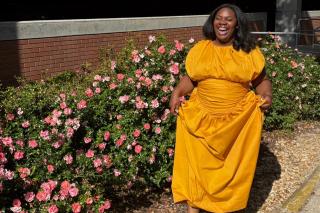Breanna J. McDaniel ’14MA has a talent for poetic, lyrical storytelling. While she does not compose music, per se, she does have something in common with many rhythm and blues (R&B) artists.
“A lot of R&B singers get their start in the church,” says McDaniel, “and so did I.”
McDaniel was raised in the Seventh-Day Adventist faith. Throughout her childhood, every service included a children’s story. “By the time I was seven or eight years old, I was writing my own stories — object lessons to present to other children in the church.”
Communicating via story-telling was a core feature of McDaniel’s upbringing. “I was always finding ways to communicate that could touch other people, impact other people,” she says, noting that she was surrounded by storytellers from a young age: most notably, her grandmother, her aunties, and an uncle. “I had a template for how to tell a good story. Children are really open and receptive to those kinds of connections.”
A childhood punctuated by storytelling provided a connection to the subject of her most recent picturebook, Go Forth and Tell: The Life of Augusta Baker, Librarian and Master Storyteller (Dial Books for Young Readers-Penguin Random House, 2024).
Telling the Storyteller’s Story

When her editor at the time mentioned that there were no children’s books about librarian and storyteller Augusta Baker (1911-1998), McDaniel was intrigued. She knew about Baker, an early champion of the importance of representations of Black children in children’s literature. McDaniel had attended the Augusta Baker's Dozen, an annual event held in Baker’s honor at the Richland Library (in South Carolina) to promote oral storytelling to children.
“I’d had never written a nonfiction book, but I am a researcher,” says McDaniel, who began her research on Baker in 2020. In spite of the limitations imposed in response to the pandemic, which prevented her from visiting archives and viewing primary sources, McDaniel gathered enough material for a draft.
Perhaps too much material, according to her editor.
“The first draft I sent was at least two pages of text, single-spaced,” she laughs. “My editor said, ‘that is not a picturebook!’ It was all the information I had, but it wasn’t the story.”
To find the story, she looked at commonalities; ways to connect with her subject.
“I had to focus on what was critical about [Baker’s] story to get a narrative. I saw parallels between myself and Baker. She was close to her grandmother, who was a storyteller, just like mine. Baker also had this home away home journey with the South. I had a similar experience, going North and then returning to the South to rest.”
All of the material McDaniel collected that didn’t fit the picturebook narrative became backmatter. “[The publisher] let me put a lot of that information in the timeline, which was great for me, as a researcher!” The book also includes McDaniel’s bibliography and an author’s note about the impact of her own childhood librarian, Michelle Carnes, who “helped me grow into the scholar and writer I am today.”
The Road to Simmons
After completing her undergraduate degree at Emory University and subsequently working at the University, McDaniel expressed her interest in writing for children. Her mentor, Simmons graduate and Emory Professor Nagueyalti Warren, told her about the Master’s in Children’s Literature Degree. “I’d never seen myself going beyond my bachelor’s degree,” McDaniel says, recalling her initial hesitation. “I grew up in Atlanta and lived in a rural town. We didn’t have any bookstores, so I’d never seen an author or had an author visit my school. I didn’t know that the master’s would help me write and get published.”
While she researched other programs, the Center for the Study of Children’s Literature at Simmons seemed to offer what she was looking for. “This program [at Simmons] has a lot of historical context behind it. That meant more to me than just learning how to write. I wanted a historical connection to children’s literature. I wondered why literature for children was important and I knew Simmons would provide the answer.”
While at Simmons, McDaniel focused on literary critique instead of writing.
“You don’t get fed ideals,” she says of the program. “You get a nurturing of truth, of intention and focus. You get a sense of possibilities. It’s all grounded in very practical expectations and ideas. [Professor and Program Director] Cathryn Mercier and [former instructor] Megan Dowd-Lambert gave me the possibilities of what can happen next, built from the work you put into it.”
A Network of Inspiration
As for what guides McDaniel’s writing? It’s an answer close to her heart.
“I take my values from what might feel relevant to my nieces and nephews,” says McDaniel. “I love to spend time with them and hear their ideas.”
Having traveled and studied in Cambridge, England, as well as Scotland and Germany, her nieces and nephews include family relations and the children of close friends.
“I’m Auntie Bre to all of them,” she says.
“This extended network of nieces and nephews is an extended network of inspiration. Sometimes I’m writing to a younger me … otherwise I’m pretty much writing to the young people I have in my life, through actual blood or the kinship of my found family.”

